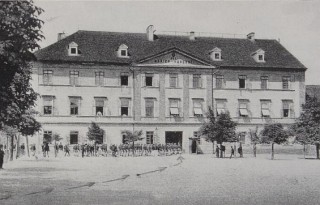
Mariánská kasárna in CB (Budweis). Until 1 June 1915 it was the home of the Good Soldier Švejk's Infanterieregiment Nr. 91. In 1915 Jaroslav Hašek also served with the regiment in these barracks.
The novel The Good Soldier Švejk refers to a number of institutions and firms, public as well as private. On these pages they were until 15 September 2013 categorised as 'Places'. This only partly makes sense as this type of entity can not always be associated with fixed geographical points, in the way that for instance cities, mountains and rivers can. This new page contains military and civilian institutions (including army units, regiments etc.), organisations, hotels, public houses, newspapers and magazines.
The line between this page and "Places" is blurred, churches do for instance rarely change location, but are still included here. Therefore Prague and Vienna will still be found in the "Places" database, because these have constant coordinates. On the other hand institutions may change location: Odvodní komise and Bendlovka are not unequivocal geographical terms so they will from now on appear on this page.
The names are colour coded according to their role in the plot, illustrated by these examples: U kalicha as a location where the plot takes place, k.u.k. Kriegsministerium mentioned in the narrative, Pražské úřední listy as part of a dialogue, and Stoletá kavárna, mentioned in an anecdote.
 Institutions index of institutions, taverns, military units, societies, periodicals ... (288)
Show all
Institutions index of institutions, taverns, military units, societies, periodicals ... (288)
Show all I. In the rear
I. In the rear  14. Švejk as military servant to senior lieutenant Lukáš (14)
14. Švejk as military servant to senior lieutenant Lukáš (14) II. At the front
II. At the front  1. Švejk's mishaps on the train (15)
1. Švejk's mishaps on the train (15) 2. Švejk's budějovická anabasis (38)
2. Švejk's budějovická anabasis (38) 3. Švejk's happenings in Királyhida (44)
3. Švejk's happenings in Királyhida (44) 4. New afflictions (26)
4. New afflictions (26)



|
I. In the rear |
 | |
15. Catastrophe | |||
 | Kostel svatého Haštala |  | |||||
| Praha I./789, Haštalská ul. 21 | |||||||
| |||||||


"Mistr Kampanus", Zikmund Winter, 1906
Kostel svatého Haštala is mentioned by Švejk when he warns Oberleutnant Lukáš not to walk Fox near U mariánského obrazu, where they have a butcher's dog that is every bit as ill-tempered as the beggar from the Saint Castulus church.
Background
Kostel svatého Haštala (Church of Saint Castulus) is a church in Prague, Staré město, built in Gothic style. It is named after Saint Castulus, one of the first Christian martyrs. The church is one of the oldest in Praha, the predecessor was erected in the 13th century. The current structure was consecrated in 1375 and was finished by 1399.
The beggar
Hašek may have picked the theme of the beggar and the church from the historical novel Mistr Kampanus by Zikmund Winter. It was published in 1906[a].
Quote(s) from the novel
[I.15] Jak uvidí ve svým rayoně cizího psa, hned je na něho žárlivej, aby mu tam něco nesežral. Von je jako ten žebrák od svatýho Haštala.“
Also written:Church of Saint CastulusenKirche zum heiligen Kastulusde
Literature
- Mistr Kampanus, ,1906 [a]
- Osudy kostela, fary a školy u sv. Haštala v Starém Městě Pražském,
- Z letopisů kostela a fary u sv. Haštala na Starém městě Pražském,
- Kostel sv. Haštala na Starém Městě pražském,
- Haštalská: (I.-Staré město), ,1929
| a | Mistr Kampanus | 1906 |
 | U mariánského obrazu |  | |||||
| Praha II./1011, Hybernská ul. 30 | |||||||
| |||||||

Světlotisk. J. Wagner, kolem 1906

,12.12.1909

, 1909
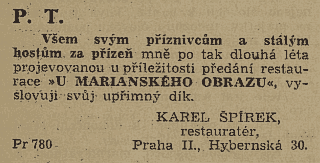
,3.10.1937
U mariánského obrazu is mentioned when Švejk informs Oberleutnant Lukáš that a mean dog, owned by a butcher, has his territory here and that he better not go there with Max.
Background
U mariánského obrazu was a restaurant in Hybernská ulice. It was located on the ground floor in number 1011, right opposite the departure hall of Státní nádraží (Staatsbahnhof), present-day Masarykovo nádraží. It should not be confused with the current restaurant (2011) by the same name in Žižkov.
There were several pubs with this name in Prague at the time, but due to the fact that the wicked dog strayed to Havlíčkovo náměstí, we can safely assume that Švejk had the pub in Hybernská in mind. It was a large tavern, obviously popular with travellers. In the decade before World War I they served beer from Smíchov and Plzeň and offered soup from five o'clock in the morning!
Long history
The restaurant has a history at least back to 1877 in what was then house number 104. In 1878 some Leopold Ortl became landlord. Some time around 1890 the old house was demolished and number 1011 erected on the site. The restaurant continued operating in the new building. From 1897 and at least until 1914 Josef Šašek was landlord, running the place together with his wife Marie. The couple and their three children lived on the premises.
The address book from 1939 shows that the establishment was still operating, managed by Jan Cimický. He had presumably succeeded Karl Špirek who had managed the restaurant until the autumn of 1937. As late as 27 June 1948 an advert appeared in Rudé právo, but when the establishment closed down for good is not known.
Quote(s) from the novel
[I.15] A taky bych vám neradil vodit ho přes Havlíčkovo náměstí, tam se potlouká jeden zlej řeznickej pes vod ,Mariánskýho vobrazu’, kterej je náramně kousavej.
Credit: Jaroslav Šerák
Also written:Zum Marienbildde
Literature
- Románové restaurační a jiné zábavní podniky, ,2009 - 2021
- Můj omyl s Mariánským obrazem,
- Soupis pražského obyvatelstva,
- Adresář královského hlavního města Prahy a obcí sousedních, ,1910
- Adresář Protektorátu Čechy a Morava..., ,1939
- Versuchter Raubanfall, ,20.12.1877
- Leopold Ortl, ,30.11.1878
- Chtěli oklamati loterii a oklamali sebe, ,6.11.1888
- Velkorestaurace "U Marianského obrazu", ,2.1.1898
- Selbstmordversuch eines Piccolo, ,19.8.1905
- Velkorestaurace :U Marianského obrazu:, ,28.6.1914
- Buffet restaurace, ,27.6.1948
 | Číňan Staněk |  | |||
| Praha II./40, Ferdinandova tř. 32 | |||||
| |||||
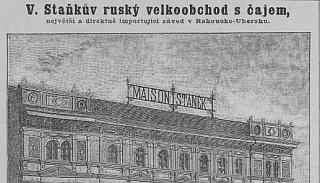
Petr Štembera, Nový Orient, 1996
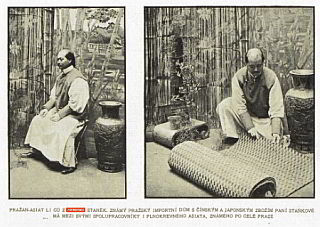
, 1913
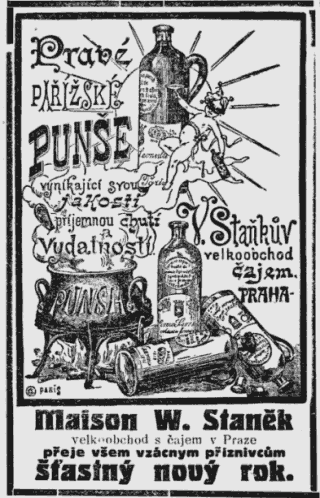
, 3.1.1914
Číňan Staněk was a "Chinese" who had a convex mirror. Švejk told Oberleutnant Lukáš this story when the latter was wondering if he liked his own looks. Švejk revealed that he did not like the sight of himself in Staněk's mirror.
Background
Číňan Staněk no doubt refers to the warehouse Maison Staněk. It was located at Ferdinandova třída 32, with stores and offices at the nearby Vladislavova ulice no. 13 (from 1896 no. 17). They imported and sold art and industrial goods from the Far East, tea, wine and rum. They also manufactured bamboo furniture. The firm was founded in 1876 by Vilém Staněk and adverts from after 1880 reveal that they focused on importing tea. The firm's name was Staňkův ruský obchod s čajem (Staněk's Russian tea trade).
Thus it was not a question of a "Chinese" in the true meaning of the word although the Chinese Li Gü was employed there and was well known in the city. One of the shop windows displayed a convex mirror.
Vilém Staněk
The owner was born in 1853 and was only 23 when he established the enterprise. He had travelled a fair deal in British and French colonies, amongst them India, and had lived in Paris for a few years. The firm grew rapidly and full-page adverts in Prager Tagblatt a.o. reveal details from their history. They were represented in several cities around the world, amongst them Yokohama and Hong Kong. In 1909 they opened a new outlet in Pilsen.
Every year Staněk attended auctions in Nishny Novgorod and London. He wrote expert articles on tea and also published the magazine Staňkův Světem (Staněk across the world). It appeared from 1889 to 1896, with content in Czech and German, edited by Hanuš Wahner. Staněk was regarded a master at marketing, helped by his younger brother Emanuel who provided illustrations.
Staněk died on 22 November 1893 from lung tuberculosis, at a mere age of 40. His wife Kateřina (born 1866) took over the enterprise after her husband passed away. The company remained in business until 1938 when it went bankrupt.
Quote(s) from the novel
[I.15] „Poslušně hlásím, pane obrlajtnant, že se nelíbím, jsem v tom zrcadle nějakej takovej šišatej nebo co. Vono to není broušený zrcadlo. To jednou měli u toho Číňana Staňka vypouklý zrcadlo, a když se někdo na sebe podíval, tak se mu chtělo vrhnout. Huba takhle, hlava jako dřez na pomeje, břicho jako u napitýho kanovníka, zkrátka figura. Šel kolem pan místodržitel, podíval se na sebe a hned to zrcadlo museli sundat.“
Credit: Milan Hodík, Petr Štembera
Literature
- Staněk's Importgesellschaft, ,16.12.1883
- Pokud se vývozu čaje týká, Vilém Staněk,17.3.1888
- Staňkův Světem, ,20.9.1890
- China und Japan in Prag, ,20.12.1891
- Sterbefälle, ,22.11.1893
- Staneks Importhaus, ,2.10.1909
- Maison Staněk anebo zboží z Orientu, ,1.1996
- Kateřina Staňeková,
- Adressář královského hlavního města Prahy, ,1884
- Adressář královského hlavního města Prahy, ,1892
- Adressář královského hlavního města Prahy, ,1896
- Adresář královského hlavního města Prahy, ,1907
- Adresář královského hlavního města Prahy, ,1910
- Adresář hlavního města Prahy, ,1936
 | Oberkommando |  | |||
| |||||
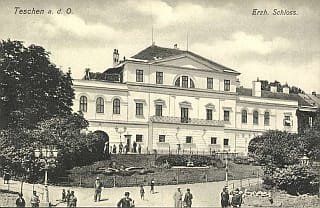
Archduke Friedrich's palace served as the headquarters of k.u.k. Armeeoberkommando from 1914 to 1916.
Oberkommando is mentioned Oberst Kraus when he tells Oberleutnant Lukáš that high command had informed that there is a lack of officers at Infanterieregiment Nr. 91 because the serbs had killed them all.
Background
Oberkommando (High Command) in this context seemingly refers to AOK, the highest military authority during the war. From the outbreak of war the formal head was Archduke Friedrich but the war effort was for most practical purposes directed by k.u.k. Generalstab, headed by Feldmarschall Conrad. At the time of the plot in The Good Soldier Švejk Armeeoberkommando was located in Teschen (now Cieszyn)[a], in the palace that was incidentally owned by Friedrich himself[b].
In The Good Soldier Švejk the terms Oberkommando and Militärkommando both probably refer to AOK, although commands at subordinated levels can't be ruled out.
Quote(s) from the novel
[I.15] Vrchní velitelství nedávno nám oznámilo, že jest u 91. pluku velký nedostatek důstojnictva, poněvadž to všechno Srbové pobili. Zaručuji se vám čestným slovem, že do tří dnů jste u 91. pluku v Budějovicích, kde se formují maršbatalióny.
Also written:High Commanden
Literature
- AT-OeStA/KA FA AOK Armeeoberkommando (AOK), 1914-1918 (Bestand), [a]
- Habsburg Palace, Cieszyn, [b]
- Conrad von Hötzendorf und das AOK, ,2014
| a | AT-OeStA/KA FA AOK Armeeoberkommando (AOK), 1914-1918 (Bestand) | ||
| b | Habsburg Palace, Cieszyn |



|
I. In the rear |
 | |
15. Catastrophe | |||
| © 2008 - 2024 Jomar Hønsi | Last updated: 20.11.2024 |


